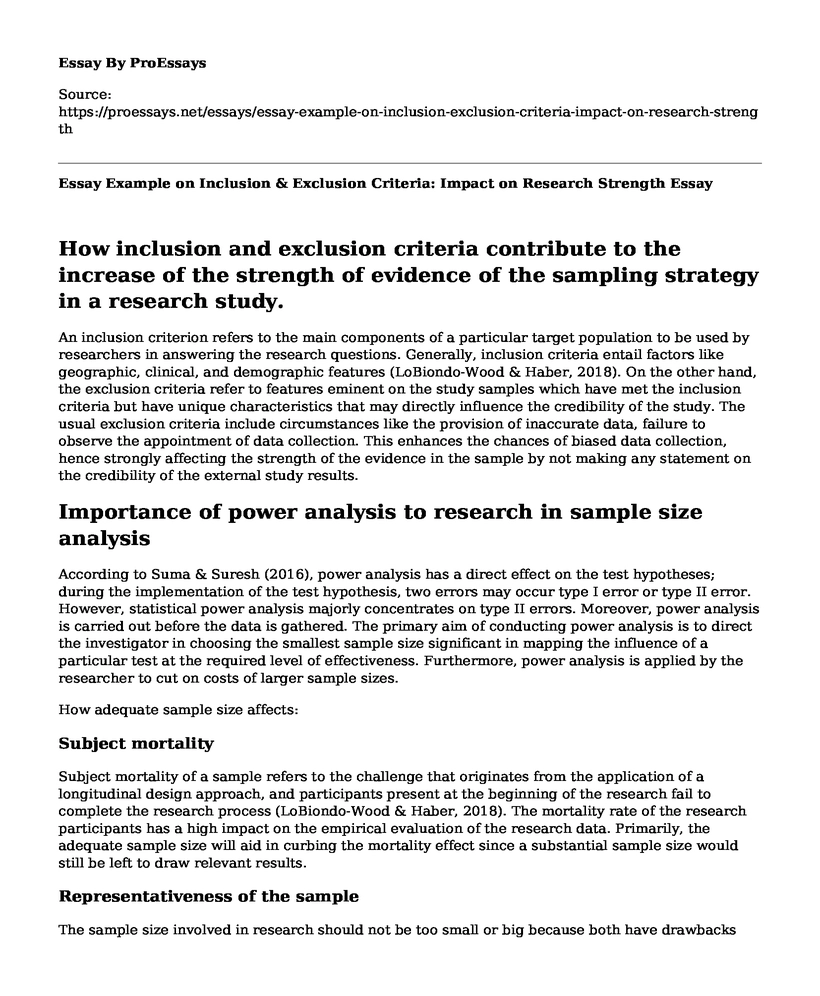How inclusion and exclusion criteria contribute to the increase of the strength of evidence of the sampling strategy in a research study.
An inclusion criterion refers to the main components of a particular target population to be used by researchers in answering the research questions. Generally, inclusion criteria entail factors like geographic, clinical, and demographic features (LoBiondo-Wood & Haber, 2018). On the other hand, the exclusion criteria refer to features eminent on the study samples which have met the inclusion criteria but have unique characteristics that may directly influence the credibility of the study. The usual exclusion criteria include circumstances like the provision of inaccurate data, failure to observe the appointment of data collection. This enhances the chances of biased data collection, hence strongly affecting the strength of the evidence in the sample by not making any statement on the credibility of the external study results.
Importance of power analysis to research in sample size analysis
According to Suma & Suresh (2016), power analysis has a direct effect on the test hypotheses; during the implementation of the test hypothesis, two errors may occur type I error or type II error. However, statistical power analysis majorly concentrates on type II errors. Moreover, power analysis is carried out before the data is gathered. The primary aim of conducting power analysis is to direct the investigator in choosing the smallest sample size significant in mapping the influence of a particular test at the required level of effectiveness. Furthermore, power analysis is applied by the researcher to cut on costs of larger sample sizes.
How adequate sample size affects:
Subject mortality
Subject mortality of a sample refers to the challenge that originates from the application of a longitudinal design approach, and participants present at the beginning of the research fail to complete the research process (LoBiondo-Wood & Haber, 2018). The mortality rate of the research participants has a high impact on the empirical evaluation of the research data. Primarily, the adequate sample size will aid in curbing the mortality effect since a substantial sample size would still be left to draw relevant results.
Representativeness of the sample
The sample size involved in research should not be too small or big because both have drawbacks capable of rendering the conclusions obtained from the studies invalid. For instance, a considerably small sample may hinder the extrapolation of the findings (LoBiondo-Wood & Haber, 2018). Consequently, too large a sample enhances the degree of differences detection, thus effectively stressing the statistical variations which may not be clinically acceptable or relevant.
The research's ability to detect treatment effects
Optimal sampling size determination of a particular research study guarantees the necessary power in the detection of statistical relevance. Hence, it is essential to choose the correct sampling size (Suma & Suresh, 2016). Furthermore, using a large sample size exposes several participants to the research procedure, which may lead to the failure of detecting specific treatment effects. Similarly, if the study sample is underpowered, the test results become statistically inconclusive, rendering the entire process a fail.
Ability to generalize the study findings to a particular population
Employing the use of simple random sampling on a relatively large sample size dramatically aids in creating a smaller sample size from the original large sample.Consequently, it becomes easy to conduct the research and further draw realistic generalization concerning the initial large sample (LoBiondo-Wood & Haber, 2018). However, the main challenge is on picking random participants from the large sample size, which the generalization will largely depend on.
Conclusion and cosmic question.
In conclusion, proper and well-conducted nursing research needs to meet diverse requirements. Collectively, the research requirements like optimum sampling size, consideration of practical power analysis, representativeness of the sample results, and account of the subject mortality play a crucial role in the validation of the research's findings and conclusion. Based on the research topic, my cosmic research question for the class is, do you think a small sample size is better than a large sample size in determining the representativeness of a sample?
References
LoBiondo-Wood, G., & Haber, J. (2018). Nursing research: methods and critical appraisal for evidence-based practice (9th ed.). St. Louis, MO: Elsevier.
Suma, A. P., & Suresh, K. P. (2016). Sample Size Estimation and Power Analysis for Research Studies Using R. IRA-International Journal of Applied Sciences, 3(2), 113-128. Retrieved from 10.21013/jas.v3.n2.p5
Cite this page
Essay Example on Inclusion & Exclusion Criteria: Impact on Research Strength. (2023, May 17). Retrieved from https://proessays.net/essays/essay-example-on-inclusion-exclusion-criteria-impact-on-research-strength
If you are the original author of this essay and no longer wish to have it published on the ProEssays website, please click below to request its removal:
- Paper Example on Salient Characteristics of Qualitative Research
- Validity of a Source Paper Example
- NewGen Case Study Paper Example
- Analysis of the Research on Transformational Leadership Paper Example
- Paper Example on Meta-Analysis: Quantitative Analysis of Cause & Effect
- Free Report Sample on Evaluating Fairness in the Workplace
- Research Paper Sample on Secondary Analysis of Existing Data







